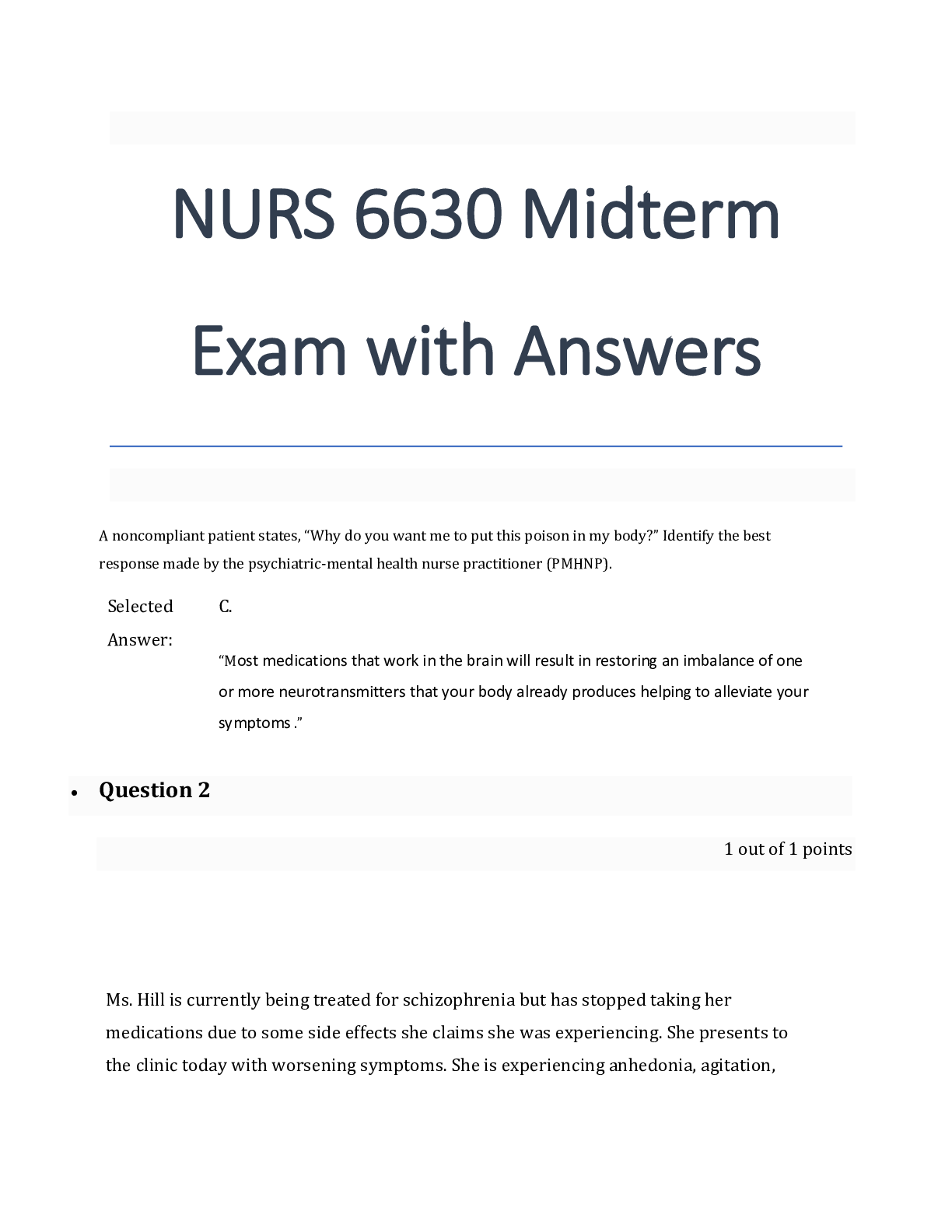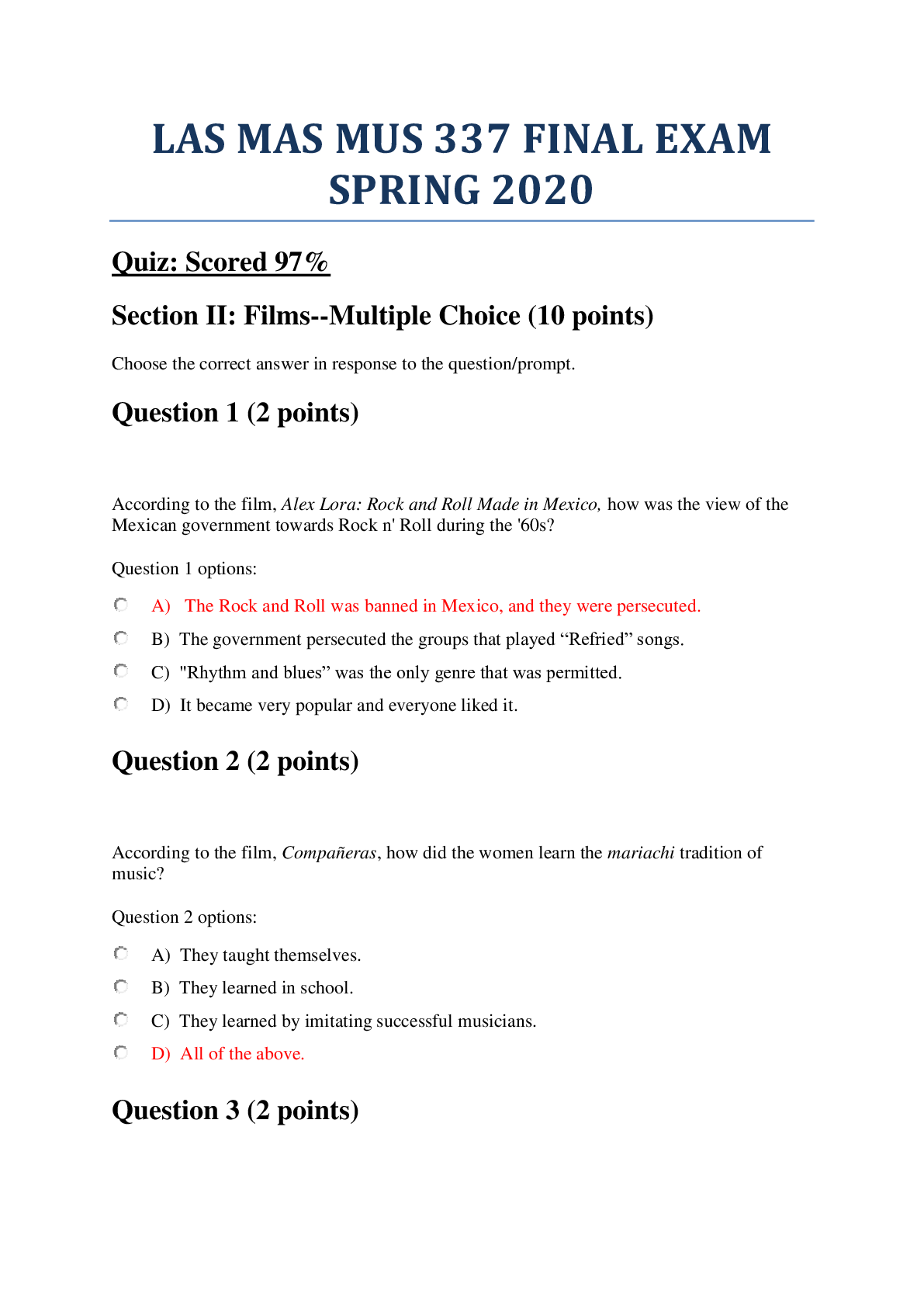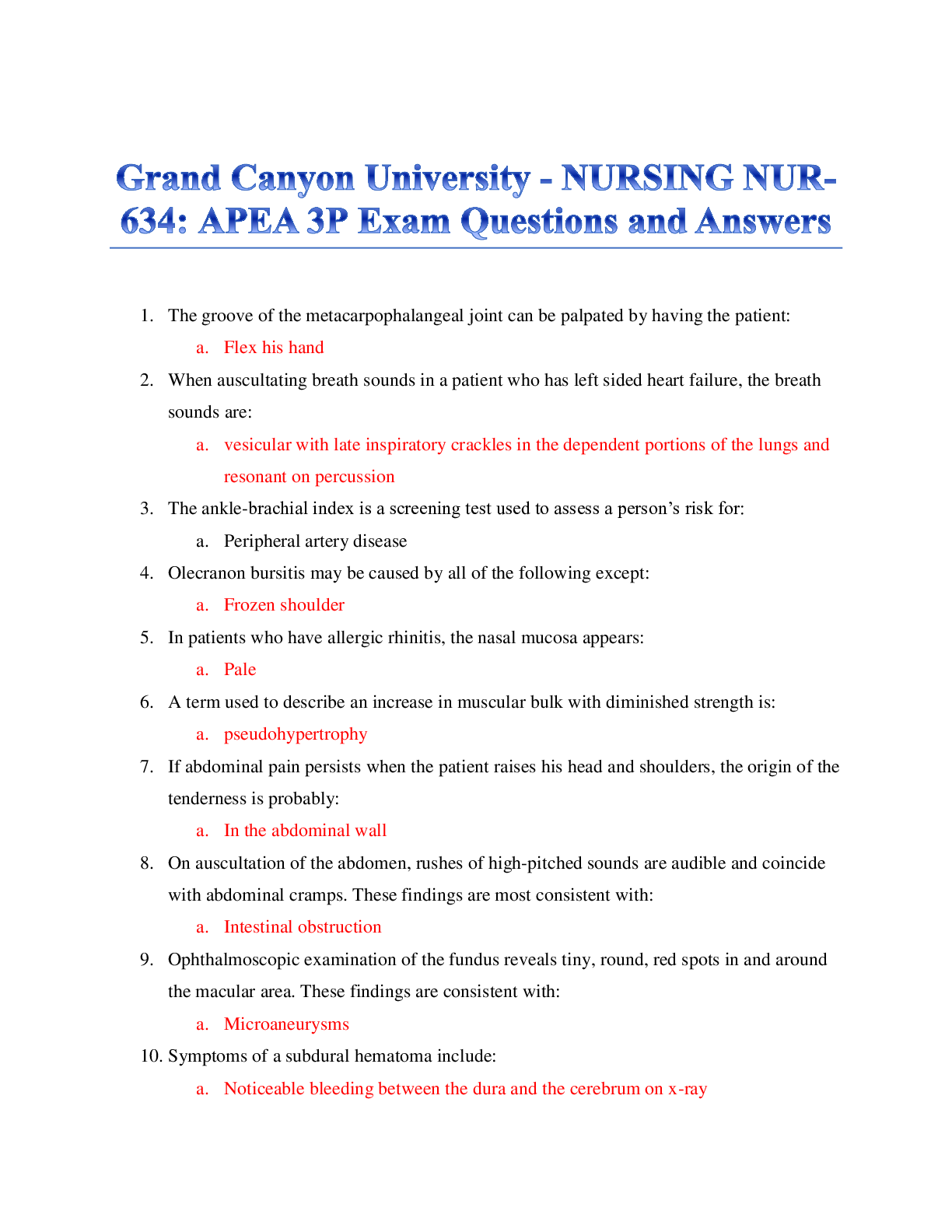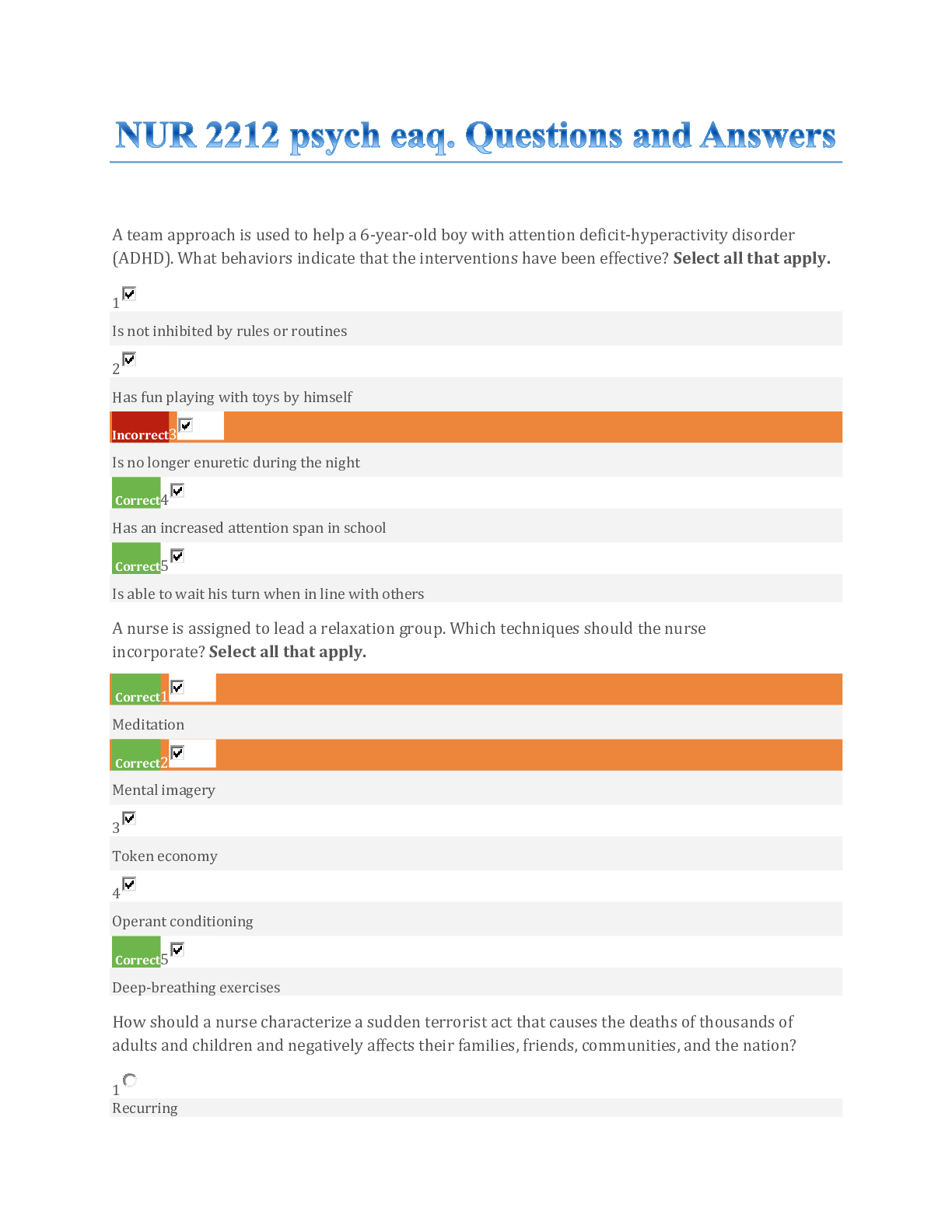NURSE MED SURGEmid term med surg. Exam. Answers With Rationale
Document Content and Description Below
NURSE MED SURGE Midterm med surg Question 1 of 30 A patient admitted for nausea reports odynophagia and feeling like food is stuck in his throat. What question should the nurse ask first? A patient... admitted for nausea reports odynophagia and feeling like food is stuck in his throat. What question should the nurse ask first? "Do you have a lot of flatulence?" "Do you have any dental cavities?" "Have you lost 20 pounds or more recently?" "Have you ever had a feeling like water in the back of your throat with no taste?" Question 2 of 30 The nurse is caring for a patient with gastroesophageal reflux disease (GERD) who presents with retrosternal burning. What term does the nurse use to document this symptom? The nurse is caring for a patient with gastroesophageal reflux disease (GERD) who presents with retrosternal burning. What term does the nurse use to document this symptom? Globus Pyrosis Halitosis Water brash p. 1088 Question 3 of 30 The nurse is assessing a patient who reports nausea, indigestion, and heartburn. Upon reviewing the patient's lab results, the nurse observes the patient's electrolyte levels are normal. Which condition does the nurse most expect the patient to have? The nurse is assessing a patient who reports nausea, indigestion, and heartburn. Upon reviewing the patient's lab results, the nurse observes the patient's electrolyte levels are normal. Which condition does the nurse most expect the patient to have? Anorexia Depression Hypothyroidism Obstructive sleep apnea (OSA) Test-Taking Tip: Identifying content and what is being asked about that content is critical to your choosing the correct response. Be alert for words in the stem of the item that are the same or similar in nature to those in one or two of the options . Question 4 of 30 A patient with gastroesophageal reflux disease (GERD) reports onset of midsternal chest pain radiating to the left arm. What is the correct priority action by the nurse? A patient with gastroesophageal reflux disease (GERD) reports onset of midsternal chest pain radiating to the left arm. What is the correct priority action by the nurse? Reassure the patient that this is a common symptom of GERD Report this symptom to the provider so the cause can be determined Administer pain medications if ordered and continue to evaluate pain Elevate the head of the patient's bed to 30 degrees to minimize reflux Question 5 of 30 Which statement about pre-diabetes is correct? Which statement about pre-diabetes is correct? It describes an overweight person with insulin-dependent diabetes. It involves an inability to respond to insulin or make sufficient insulin in the pancreas. It is a form of type 1 diabetes that tends to occur in people over age 50 years who are slender. It describes people at risk for type 2 diabetes who have a fasting glucose level of 100 to 125 mg/dL. p. 1287 Which statement about blood pressure, as it relates to diabetes mellitus, is correct? Which statement about blood pressure, as it relates to diabetes mellitus, is correct? Individuals with diabetes and hypertension are at increased risk for liver damage. Patients with diabetes should keep their blood pressure below 130/80 mm Hg. Diabetic ketoacidosis is of higher concern in people with type 2 diabetes than is hypertension. People with diabetes and hypertension are at higher risk for visual impairment from cataracts. p. 1284 The nurse is reviewing the implications of culture on the development of diabetes. Which patient will the nurse determine has the greatest risk for developing type 2 diabetes mellitus? The nurse is reviewing the implications of culture on the development of diabetes. Which patient will the nurse determine has the greatest risk for developing type 2 diabetes mellitus? 44-year-old healthy American Indian patient with a family history of type 2 diabetes 60-year-old Asian American patient with an unknown family history of type 2 diabetes 55-year-old healthy non-Hispanic white patient with a family history of cardiovascular disease 22-year-old healthy Hispanic patient with an unknown family history of type 2 diabetes Test-Taking Tip: Multiple-choice questions can be challenging because students think that they will recognize the right answer when they see it or that the right answer will somehow stand out from the other choices. This is a dangerous misconception. The more carefully the question is constructed, the more each of the choices will seem like the correct response. Question 8 of 30 What will the nurse teach a patient with diabetes mellitus with nephropathy and the patient’s family about this condition? What will the nurse teach a patient with diabetes mellitus with nephropathy and the patient’s family about this condition? "The severity of this condition depends on your average blood glucose level." "This condition generally only occurs in patients with type 1 diabetes mellitus." "This condition generally only occurs in patients with type 2 diabetes mellitus." "The severity of this condition depends on how long you have had diabetes mellitus." Test-Taking Tip: Identify option components as correct or incorrect. This may help you identify a wrong answer. Question 9 of 30 The nurse is teaching the parents of a pediatric patient who has recently been diagnosed with type 1 diabetes mellitus. What statement will the nurse include about the pathophysiology of the disease? The nurse is teaching the parents of a pediatric patient who has recently been diagnosed with type 1 diabetes mellitus. What statement will the nurse include about the pathophysiology of the disease? "The body starts to attack itself and destroy the cells that convert insulin in the liver." "The body starts to attack itself and destroy the cells that make insulin in the pancreas." "Consistently high insulin levels leads to the inability of the cells to recognize and utilize the insulin." "Consistently high glucose levels leads to the increase in insulin secretion that cannot be utilized by the cells." Question 10 of 30 Which patient has the highest risk for decreased perfusion? Which patient has the highest risk for decreased perfusion? Child with type 1 diabetes and pale skin Older adult with obesity and diabetes mellitus Adult with hyperlipidemia and arteriosclerosis Adolescent who smokes and has a family history p. 25 Question 11 of 30 What could be the reason for premature atherosclerosis in a patient with severe diabetes mellitus? What could be the reason for premature atherosclerosis in a patient with severe diabetes mellitus? Increased blood pressure Decreased triglycerides (TGs) Increased low-density lipoprotein-cholesterol (LDL- C) Decreased high-density lipoprotein-cholesterol (HDL- C) Question 12 of 30 A patient with diabetes mellitus has had a cholecystectomy. The nurse prioritizes blood glucose management in the patient's plan of care for which reason? A patient with diabetes mellitus has had a cholecystectomy. The nurse prioritizes blood glucose management in the patient's plan of care for which reason? Patients who are diagnosed with diabetes have increased anxiety. Patients with postoperative hyperglycemia are prone to poor wound healing. Patients with diabetes who undergo surgery are likely to develop hypoglycemia. Patients with diabetes should not receive insulin when they do not eat a meal. Question 13 of 30 A patient admitted with diabetic ketoacidosis was treated for metabolic acidosis with intravenous (IV) fluids and insulin. Which electrolyte imbalance does the nurse monitor for as the acid-base imbalance resolves? A patient admitted with diabetic ketoacidosis was treated for metabolic acidosis with intravenous (IV) fluids and insulin. Which electrolyte imbalance does the nurse monitor for as the acid-base imbalance resolves? Hyponatremia Hypokalemia Hyperkalemia Hypernatremia p. 196 Question 14 of 30 Which age-related change to the endocrine gland affects fluid balance in the body? Which age-related change to the endocrine gland affects fluid balance in the body? Adrenal atrophy Insulin resistance Increased secretion of aldosterone Decreased secretion of antidiuretic hormone p. 165 Study mode ON Question 15 of 30 The nurse is teaching a patient about maintaining a proper diet to prevent an endocrine disorder. The patient states that she does not like fish. What should the nurse teach the patient? The nurse is teaching a patient about maintaining a proper diet to prevent an endocrine disorder. The patient states that she does not like fish. What should the nurse teach the patient? "Eat more red meat." "Eat more green vegetables." "Use iodized salt for cooking." "Use salt substitute for cooking." STUDY TIP: Begin studying by setting goals. Make sure they are realistic. A goal of scoring 100% on all exams is not realistic, but scoring an 85% may be a better goal. Question 16 of 30 The nurse assesses the skin and hair of a patient for endocrine disorders. Which finding is a cause for concern? The nurse assesses the skin and hair of a patient for endocrine disorders. Which finding is a cause for concern? There is no long-standing unhealed wound. There is no significant change in the texture of the hair. The patient has not experienced a change in shaving pattern. Skin over the finger joints and elbows shows hyperpigmentation. p. 1242 Question 17 of 30 A patient presents with freckles, birthmarks, and age spots. The laboratory reports show endocrine changes and inflammation. Which cells would be responsible for this condition? A patient presents with freckles, birthmarks, and age spots. The laboratory reports show endocrine changes and inflammation. Which cells would be responsible for this condition? Fat cells Fibroblasts Melanocytes Keratinocytes Test-Taking Tip: Identify option components as correct or incorrect. This may help you identify a wrong answer. p. 432 Question 18 of 30 The charge nurse on the medical-surgical unit is making patient assignments for the shift. Which patient is the most appropriate to assign to an LPN/LVN? The charge nurse on the medical-surgical unit is making patient assignments for the shift. Which patient is the most appropriate to assign to an LPN/LVN? Patient with possible pituitary adenoma who has just arrived on the nursing unit Patient with exophthalmos who has many questions about endocrine function Patient with Cushing's syndrome who requires orthostatic vital signs assessments Patient with diabetes mellitus who was admitted with a blood glucose of 45 mg/dL Test-Taking Tip: Try putting questions and answers in your own words to test your understanding. p. 1242 Study mode ON Question 19 of 30 A patient is scheduled for urine analysis for endocrine testing. Which teaching will the nurse provide? A patient is scheduled for urine analysis for endocrine testing. Which teaching will the nurse provide? Avoid placing the specimen in ice. Add preservative after the collection. Save the urine specimen at the beginning of the collection. Stop the collection of urine after the allotted 24-hour time period. Question 20 of 30 What class of drugs is most appropriate for treating hyperparathyroidism? What class of drugs is most appropriate for treating hyperparathyroidism? Diuretics Hormones Calcimimetics Glucocorticoids p. 1276 Question 21 of 30 Which endocrine gland produces growth hormone (GH)? Which endocrine gland produces growth hormone (GH)? Thyroid Hypothalamus Anterior pituitary Posterior pituitary p. 1237 Question 22 of 30 The nurse is caring for four patients with endocrine disorders. Which patient is likely to present with a positive Chvostek's and Trousseau's sign? Patient A Patient B Patient C Patient D Question 23 of 30 Which procedure does the nurse anticipate for the patient with suspected muscular dystrophy? Which procedure does the nurse anticipate for the patient with suspected muscular dystrophy? Arthroscopy Myelography Muscle biopsy Magnetic resonance imaging (MRI) Test-Taking Tip: Be alert for details. Details provided in the stem of the item, such as behavioral changes or clinical changes (or both) within a certain time period, can provide a clue to the most appropriate response or, in some cases, responses. p. 1013 Question 24 of 30 A surgical repair was done shortly after injury in a patient with a rotator cuff injury using arthroscopy. What could a presurgical magnetic resonance imaging (MRI) of the shoulder reveal? A surgical repair was done shortly after injury in a patient with a rotator cuff injury using arthroscopy. What could a presurgical magnetic resonance imaging (MRI) of the shoulder reveal? Muscular atrophy Full-thickness tear Fatty replacement Partial-thickness tear Test-Taking Tip: Do not worry if you select the same numbered answer repeatedly because there usually is no pattern to the answers. p. 1059 Question 25 of 30 The serum calcium level of a patient with a femoral fracture is 12 mg/dL. What type of fracture does the nurse suspect that the patient has? The serum calcium level of a patient with a femoral fracture is 12 mg/dL. What type of fracture does the nurse suspect that the patient has? Fatigue fracture Buckled fracture Greenstick fracture Pathologic fracture Test-Taking Tip: You have at least a 25% chance of selecting the correct response in multiple-choice items. If you are uncertain about a question, eliminate the choices that you believe are wrong and then call on your knowledge, skills, and abilities to choose from the remaining responses. p. 1035 Question 26 of 30 Which type of fracture has the highest incidence in young and young middle-aged adults? Which type of fracture has the highest incidence in young and young middle-aged adults? Rib fractures Humeral fractures Femoral shaft fracture Proximal femoral fractures Question 27 of 30 The nurse is reviewing the clinical data of four patients. Which patient is at high risk for bone fractures? Patient A Patient B Patient C Patient D Test-Taking Tip: Read the data carefully and correlate with the concepts of parathyroidism to select the correct option. Question 29 of 30 Which ulcers usually develop due to H. pylori infection? Which ulcers usually develop due to <i>H. pylori</i> infection? Stress ulcers Gastric ulcers and stress ulcers Duodenal ulcers and stress ulcers Gastric ulcers and duodenal ulcers pp. 1107-1108 Question 30 of 30 What are potential complications of Crohn's disease? Select all that apply. What are potential complications of Crohn's disease? Select all that apply. Fistulas Osteoporosis Malabsorption Stomach cancer Abscess formation Rationale The complications of Crohn's disease include abscess formation, colon cancer, malabsorption, fistulas, and osteoporosis. Stomach cancer is not a complication of Crohn's disease; colorectal cancer, however, is a possible complication of ulcerative colitis. p. 1151 [Show More]
Last updated: 2 years ago
Preview 1 out of 24 pages

Buy this document to get the full access instantly
Instant Download Access after purchase
Buy NowInstant download
We Accept:

Reviews( 0 )
$9.00
Can't find what you want? Try our AI powered Search
Document information
Connected school, study & course
About the document
Uploaded On
Jun 23, 2020
Number of pages
24
Written in
Additional information
This document has been written for:
Uploaded
Jun 23, 2020
Downloads
0
Views
142














